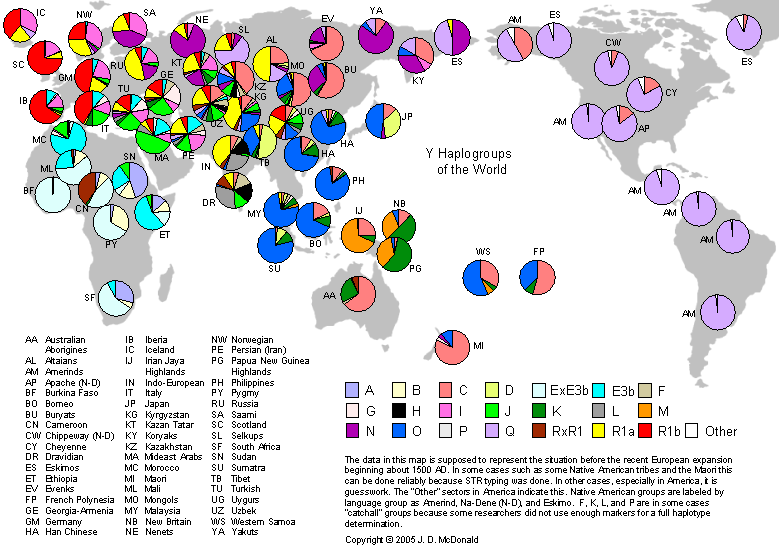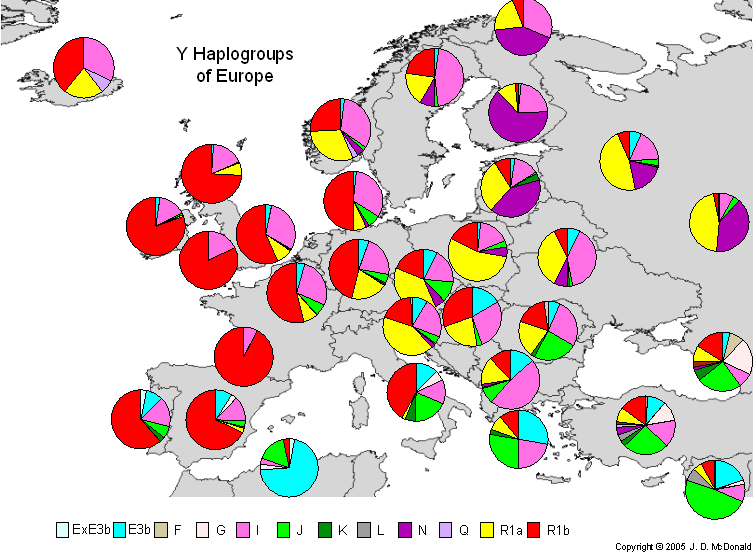Prehistoric DNA Journeys
The previous pages in this series have discussed the history of the Clan Donald starting early in the Christian era. But DNA can tell us, in a general sense, about migrations much longer ago. For these discussion, we do not use those lists of STR numbers like 13-24-14-10-11-14 but rather the Haplogroup designations E, I, R1a, and R1b. These tell stories that stretch back 10,000 to 30,000 years.
The idea of using haplogroups to study ancient migrations is simple: it is likely that a haplogroup originated where one finds the largest number of different haplotypes in it. Many academic studies have measured this. As time went on, men migrated to new places and their descendants multiplied again and again. The descendants of the most successful men grew to dominate the population. The destination areas have a lower genetic diversity. Scotland is an area of very low diversity. Doug has made maps of Y chromosome distributions of the whole world

and of Europe showing the current distribution of haplogroups, except for America where he has tried to back-calculate the situation as it was in the year 1492. The current distribution is not all that different from the situation during Somerled's lifetime.

We now discuss where you can expect to have found your very distant ancestors in prehistoric times.
E-M35
Though E-M35 (formerly E3b) likely originated in East Africa some 25,000 years ago, it came to Europe about 9000 years from the Middle East. Today the variety of it (E-M78 ) common in Europeans is found most commonly on the shores of the Mediterranean. E-M35 is rare in the British Isles, and especially so in Scotland.
G-M201
Haplogroup G is generally thought of as being a predominantly Middle Eastern group, from where it spread to the Mediterranean areas of Europe. It is rare in the British Isles and even more so in Scotland.
I
I is a strongly European haplogroup, present almost exclusively there. The mutation that defined it apparently occurred in Europe. It is a young group, less than 25,000 years old.
There are several subdivisions, which currently (November 2008) are called different things by different groups. We have changed our nomenclature to use the name of the defining SNP for that group. Plain I with no suffix means that a person has been tested positive for one of the markers P19, P38, or M170, or can be projected to be positive for those, but the available information is insufficient to distinguish further. I-M307 (formerly I1a) means someone has tested positive for M307, or the equivalents P30 or M253, or has a haplotype that unambiguously indicates that group. I-P37.2 (formerly I1b) means someone has tested positive for P37.2, or has a haplotype that unambiguously indicates that group. I-M223 (formerly I1c) means someone has tested positive for M223, or has a haplotype that unambiguously indicates that group.
The ISOGG web site describes the subdivisions roughly as follows: I-M307 has highest frequency in Scandinavia, Iceland, and northwest Europe. In Britain, haplogroup I-M307 et al is often used as a marker for "invaders," Viking or Anglo-Saxon. I-P37.2 is a common form in the Balkans and Sardinia. I-M223 occurs in Britain and northwest continental Europe.
J-M172
J-M172 (formerly J2) is thought to have originated in the Mideast, likely Iraq, some 7000 to 10,000 years ago and spread east and west. Today it is very prominent along the northeast shore of the Mediterranean from Israel to Italy, and north as far as Georgia and Romania, and in Mideastern Arabs.
R1a-M420: The Haplogroup of Somerled
R1a-M420, the extremely dominant subdivision of R1a, probably arose about 10,000 to 8,000 years ago in the people who lived just south of the glaciers then dominating Eurasia. It's exact original location is controversial, with proposals ranging from Ukraine in the west to Kazakhstan in the east. All the proposals do center on the wide grasslands that sweep across this part of the world, where peoples associated with the origin of the Indo-European language family and the domestication of the horse spread it widely. Today it is very dominant in Pakistan and Afghanistan, and is prominent in northern India, Kyrgyzstan, and the Slavic countries of Eastern Europe. It appears farther west in Europe but is a minor player there. This implies that it moved from east to west.
It is also the group of the Clan leaders of the Clan Donald. However, our leaders and almost all other R1a1 men in our Clan do not come, at least not recently, from southern Asia or the Slavic lands. We can tell this because our haplotypes have some very characteristic features which differ from the common patterns elsewhere. This is most importantly the 21 at YCAII-b. Slavic, Polish, German, and importantly Danish and Swedish R1a is normally 23 at YCAIIb. This change occurred about 2000 years ago along with the appearance of the SNP CLFY1 (aka CLD36a). Our pattern is seen almost exclusively in Norway, adjacent parts of Scandinavia (though not at all in Denmark), Iceland, and the parts of Highland Scotland and the Western Isles where it is associated mostly with the Clan Donald itself. This pattern of the "Norse R1a" as it is best called has lead to the deduction that it came to Scotland with the Norse Vikings (not Danish Vikings). When tied with our Clan history and the very name "Somerled", which is the English version of the Gaelic version of a Norse word meaning "Viking" , this becomes a near certainty.
R1b-M269
R1b-M269 is the dominant haplogroup in the British Isles, and adjacent parts of mainland Europe, so it is only to be expected that most Clan Donald men who do not originate from Somerled himself are R1b. R1b-M269 originated in Southwest Asia about 6000 years ago. Our group of R1b people is extremely diffuse, indications that most MacDonalds in it adopted the MacDonald surname quite independently.
The nomenclature of R1b is currently in flux. See the ISOGG chart. This chart may not agree with what Family Tree DNA itself calls various sub-haplogroups.
